AdvMix: Adversarial Mixing Strategy for Unsupervised Domain Adaptive Object Detection
Abstract
:1. Introduction
- We propose an unsupervised cross-domain adaptive method, AdvMix, which is a joint adversarial feature alignment and region mixing self-training strategy to reduce style and content gaps simultaneously;
- To address the style gap, a novel AdvGRL is introduced to align global image styles from multi-scale feature maps and enhance the stability of domain-invariant features by hard examples mining;
- To diminish the content gap, we employ a self-supervised training strategy based on region mixing and design a strict confidence metric to improve the reliability of self-training.
2. Related Work
2.1. Object Detection
2.2. Unsupervised Domain Adaptation
3. Method
3.1. Overall Framework
3.2. AdvGRL
3.3. Region Mixing Module
3.4. Training Algorithm
4. Experiments
4.1. Dataset and Experimental Setup
4.2. Detection Results on Domain Adaptation
4.3. Comparison with State-of-the-Art Methods
5. Ablation Studies
5.1. Effect of Adversarial Structure
5.2. Effect of Mixing Strategy
5.3. Effect of Image Resolution
6. Discussions
6.1. Domain Adaption for Multi-Class Detection
6.2. False Detections
7. Conclusions
Author Contributions
Funding
Data Availability Statement
Conflicts of Interest
References
- Ren, S.; He, K.; Girshick, R.; Sun, J. Faster R-CNN: Towards Real-Time Object Detection with Region Proposal Networks. IEEE Trans. Pattern Anal. Mach. Intell. 2017, 39, 1137–1149. [Google Scholar] [CrossRef] [PubMed]
- Redmon, J.; Divvala, S.; Girshick, R.; Farhadi, A. You Only Look Once: Unified, Real-Time Object Detection. In Proceedings of the 2016 IEEE Conference on Computer Vision and Pattern Recognition (CVPR), Las Vegas, NV, USA, 27–30 June 2016; pp. 779–788. [Google Scholar] [CrossRef]
- Zhou, X.; Wang, D.; Krähenbühl, P. Objects as points. arXiv 2019, arXiv:1904.07850. [Google Scholar] [CrossRef]
- Krizhevsky, A.; Sutskever, I.; Hinton, G.E. ImageNet Classification with Deep Convolutional Neural Networks. Commun. ACM 2017, 60, 84–90. [Google Scholar] [CrossRef]
- He, K.; Zhang, X.; Ren, S.; Sun, J. Deep Residual Learning for Image Recognition. In Proceedings of the 2016 IEEE Conference on Computer Vision and Pattern Recognition (CVPR), Las Vegas, NV, USA, 27–30 June 2016; pp. 770–778. [Google Scholar] [CrossRef]
- Alom, M.Z.; Taha, T.M.; Yakopcic, C.; Westberg, S.; Sidike, P.; Nasrin, M.S.; Hasan, M.; Van Essen, B.C.; Awwal, A.A.S.; Asari, V.K. A State-of-the-Art Survey on Deep Learning Theory and Architectures. Electronics 2019, 8, 292. [Google Scholar] [CrossRef]
- Liu, W.; Anguelov, D.; Erhan, D.; Szegedy, C.; Reed, S.; Fu, C.Y.; Berg, A.C. SSD: Single Shot MultiBox Detector. In Proceedings of the Computer Vision—ECCV 2016; Leibe, B., Matas, J., Sebe, N., Welling, M., Eds.; Springer: Cham, Switzerland, 2016; pp. 21–37. [Google Scholar] [CrossRef]
- Tian, Z.; Shen, C.; Chen, H.; He, T. FCOS: Fully Convolutional One-Stage Object Detection. In Proceedings of the 2019 IEEE/CVF International Conference on Computer Vision (ICCV), Seoul, Republic of Korea, 27 October–2 November 2019; pp. 9626–9635. [Google Scholar] [CrossRef]
- Yang, S.Y.; Cheng, H.Y.; Yu, C.C. Real-Time Object Detection and Tracking for Unmanned Aerial Vehicles Based on Convolutional Neural Networks. Electronics 2023, 12, 4928. [Google Scholar] [CrossRef]
- Zhou, X.; Zhuo, J.; Krähenbühl, P. Bottom-Up Object Detection by Grouping Extreme and Center Points. In Proceedings of the 2019 IEEE/CVF Conference on Computer Vision and Pattern Recognition (CVPR), Long Beach, CA, USA, 15–20 June 2019; pp. 850–859. [Google Scholar] [CrossRef]
- Rezaeianaran, F.; Shetty, R.; Aljundi, R.; Reino, D.O.; Zhang, S.; Schiele, B. Seeking Similarities over Differences: Similarity-based Domain Alignment for Adaptive Object Detection. In Proceedings of the 2021 IEEE/CVF International Conference on Computer Vision (ICCV), Montreal, QC, Canada, 10–17 October 2021; pp. 9184–9193. [Google Scholar] [CrossRef]
- Li, W.; Liu, X.; Yao, X.; Yuan, Y. SCAN: Cross Domain Object Detection with Semantic Conditioned Adaptation. In Proceedings of the AAAI Conference on Artificial Intelligence, Virtual, 22 February–1 March 2022; Volume 36, pp. 1421–1428. [Google Scholar] [CrossRef]
- Mattolin, G.; Zanella, L.; Ricci, E.; Wang, Y. ConfMix: Unsupervised Domain Adaptation for Object Detection via Confidence-based Mixing. In Proceedings of the 2023 IEEE/CVF Winter Conference on Applications of Computer Vision (WACV), Waikoloa, HI, USA, 2–7 January 2023; pp. 423–433. [Google Scholar] [CrossRef]
- Li, J.; Xu, R.; Ma, J.; Zou, Q.; Ma, J.; Yu, H. Domain Adaptive Object Detection for Autonomous Driving under Foggy Weather. In Proceedings of the 2023 IEEE/CVF Winter Conference on Applications of Computer Vision (WACV), Waikoloa, HI, USA, 2–7 January 2023; pp. 612–622. [Google Scholar] [CrossRef]
- Johnson-Roberson, M.; Barto, C.; Mehta, R.; Sridhar, S.N.; Rosaen, K.; Vasudevan, R. Driving in the Matrix: Can virtual worlds replace human-generated annotations for real world tasks? In Proceedings of the 2017 IEEE International Conference on Robotics and Automation (ICRA), Singapore, 29 May–3 June 2017; pp. 746–753. [Google Scholar] [CrossRef]
- Guan, D.; Huang, J.; Xiao, A.; Lu, S.; Cao, Y. Uncertainty-Aware Unsupervised Domain Adaptation in Object Detection. IEEE Trans. Multimed. 2022, 24, 2502–2514. [Google Scholar] [CrossRef]
- VS, V.; Gupta, V.; Oza, P.; Sindagi, V.A.; Patel, V.M. MeGA-CDA: Memory Guided Attention for Category-Aware Unsupervised Domain Adaptive Object Detection. In Proceedings of the 2021 IEEE/CVF Conference on Computer Vision and Pattern Recognition (CVPR), Nashville, TN, USA, 20–25 June 2021; pp. 4514–4524. [Google Scholar] [CrossRef]
- Zhang, Y.; Wang, Z.; Mao, Y. RPN Prototype Alignment For Domain Adaptive Object Detector. In Proceedings of the 2021 IEEE/CVF Conference on Computer Vision and Pattern Recognition (CVPR), Nashville, TN, USA, 20–25 June 2021; pp. 12420–12429. [Google Scholar] [CrossRef]
- VS, V.; Oza, P.; Patel, V.M. Instance Relation Graph Guided Source-Free Domain Adaptive Object Detection. In Proceedings of the 2023 IEEE/CVF Conference on Computer Vision and Pattern Recognition (CVPR), Vancouver, BC, Canada, 17–24 June 2023; pp. 3520–3530. [Google Scholar] [CrossRef]
- Yu, F.; Wang, D.; Chen, Y.; Karianakis, N.; Shen, T.; Yu, P.; Lymberopoulos, D.; Lu, S.; Shi, W.; Chen, X. SC-UDA: Style and Content Gaps aware Unsupervised Domain Adaptation for Object Detection. In Proceedings of the 2022 IEEE/CVF Winter Conference on Applications of Computer Vision (WACV), Waikoloa, HI, USA, 3–8 January 2022; pp. 1061–1070. [Google Scholar] [CrossRef]
- Zhao, G.; Li, G.; Xu, R.; Lin, L. Collaborative Training Between Region Proposal Localization and Classification for Domain Adaptive Object Detection. In Proceedings of the Computer Vision—ECCV 2020; Vedaldi, A., Bischof, H., Brox, T., Frahm, J.M., Eds.; Springer: Cham, Switzerland, 2020; pp. 86–102. [Google Scholar] [CrossRef]
- Li, W.; Liu, X.; Yuan, Y. SIGMA: Semantic-complete Graph Matching for Domain Adaptive Object Detection. In Proceedings of the 2022 IEEE/CVF Conference on Computer Vision and Pattern Recognition (CVPR), New Orleans, LA, USA, 18–24 June 2022; pp. 5281–5290. [Google Scholar] [CrossRef]
- Ganin, Y.; Lempitsky, V. Unsupervised Domain Adaptation by Backpropagation. In Proceedings of the 32nd International Conference on Machine Learning, Lille, France, 7–9 July 2015; Volume 37, pp. 1180–1189. [Google Scholar]
- Chen, Y.; Li, W.; Sakaridis, C.; Dai, D.; Van Gool, L. Domain Adaptive Faster R-CNN for Object Detection in the Wild. In Proceedings of the 2018 IEEE/CVF Conference on Computer Vision and Pattern Recognition, Salt Lake City, UT, USA, 18–23 June 2018; pp. 3339–3348. [Google Scholar] [CrossRef]
- Zhu, X.; Pang, J.; Yang, C.; Shi, J.; Lin, D. Adapting Object Detectors via Selective Cross-Domain Alignment. In Proceedings of the 2019 IEEE/CVF Conference on Computer Vision and Pattern Recognition (CVPR), Long Beach, CA, USA, 15–20 June 2019; pp. 687–696. [Google Scholar] [CrossRef]
- Hsu, H.K.; Yao, C.H.; Tsai, Y.H.; Hung, W.C.; Tseng, H.Y.; Singh, M.; Yang, M.H. Progressive Domain Adaptation for Object Detection. In Proceedings of the 2020 IEEE Winter Conference on Applications of Computer Vision (WACV), Snowmass, CO, USA, 1–5 March 2020; pp. 738–746. [Google Scholar] [CrossRef]
- Zhou, W.; Du, D.; Zhang, L.; Luo, T.; Wu, Y. Multi-Granularity Alignment Domain Adaptation for Object Detection. In Proceedings of the 2022 IEEE/CVF Conference on Computer Vision and Pattern Recognition (CVPR), New Orleans, LA, USA, 18–24 June 2022; pp. 9571–9580. [Google Scholar] [CrossRef]
- Shan, Y.; Lu, W.F.; Chew, C.M. Pixel and feature level based domain adaptation for object detection in autonomous driving. Neurocomputing 2019, 367, 31–38. [Google Scholar] [CrossRef]
- Kim, T.; Jeong, M.; Kim, S.; Choi, S.; Kim, C. Diversify and Match: A Domain Adaptive Representation Learning Paradigm for Object Detection. In Proceedings of the 2019 IEEE/CVF Conference on Computer Vision and Pattern Recognition (CVPR), Long Beach, CA, USA, 15–20 June 2019; pp. 12448–12457. [Google Scholar] [CrossRef]
- Li, X.; Chen, W.; Xie, D.; Yang, S.; Yuan, P.; Pu, S.; Zhuang, Y. A Free Lunch for Unsupervised Domain Adaptive Object Detection without Source Data. In Proceedings of the AAAI Conference on Artificial Intelligence, Virtual, 2–9 February 2021; Volume 35, pp. 8474–8481. [Google Scholar] [CrossRef]
- Cai, X.; Luo, F.; Qi, W.; Liu, H. A Semi-Supervised Object Detection Algorithm Based on Teacher-Student Models with Strong-Weak Heads. Electronics 2022, 11, 3849. [Google Scholar] [CrossRef]
- Xu, M.; Wang, H.; Ni, B.; Tian, Q.; Zhang, W. Cross-Domain Detection via Graph-Induced Prototype Alignment. In Proceedings of the 2020 IEEE/CVF Conference on Computer Vision and Pattern Recognition (CVPR), Seattle, WA, USA, 13–19 June 2020; pp. 12352–12361. [Google Scholar] [CrossRef]
- Jocher, G.; Stoken, A.; Borovec, J.; Changyu, L.; Hogan, A.; Diaconu, L.; Poznanski, J.; Yu, L.; Rai, P.; Ferriday, R.; et al. ultralytics/yolov5: v3. 0. Available online: https://github.com/ultralytics/yolov5/tree/v3.0 (accessed on 20 December 2023).
- Luo, Q.; Wang, Y.; Li, W.; Xiong, R. Joint Feature-level and Pixel-level Domain Adaption for Object Detection in the Wild. In Proceedings of the 2019 IEEE 9th Annual International Conference on CYBER Technology in Automation, Control, and Intelligent Systems (CYBER), Suzhou, China, 29 July–2 August 2019; pp. 559–565. [Google Scholar] [CrossRef]
- Cordts, M.; Omran, M.; Ramos, S.; Rehfeld, T.; Enzweiler, M.; Benenson, R.; Franke, U.; Roth, S.; Schiele, B. The Cityscapes Dataset for Semantic Urban Scene Understanding. In Proceedings of the 2016 IEEE Conference on Computer Vision and Pattern Recognition (CVPR), Las Vegas, NV, USA, 27–30 June 2016; pp. 3213–3223. [Google Scholar] [CrossRef]
- Sakaridis, C.; Dai, D.; Van Gool, L. Semantic foggy scene understanding with synthetic data. Int. J. Comput. Vis. 2018, 126, 973–992. [Google Scholar] [CrossRef]
- Geiger, A.; Lenz, P.; Urtasun, R. Are we ready for autonomous driving? The KITTI vision benchmark suite. In Proceedings of the 2012 IEEE Conference on Computer Vision and Pattern Recognition, Providence, RI, USA, 16–21 June 2012; pp. 3354–3361. [Google Scholar] [CrossRef]
- Lin, T.Y.; Goyal, P.; Girshick, R.; He, K.; Dollar, P. Focal Loss for Dense Object Detection. In Proceedings of the IEEE International Conference on Computer Vision (ICCV), Venice, Italy, 22–29 October 2017. [Google Scholar] [CrossRef]
- Hosang, J.; Benenson, R.; Schiele, B. Learning Non-maximum Suppression. In Proceedings of the 2017 IEEE Conference on Computer Vision and Pattern Recognition (CVPR), Honolulu, HI, USA, 21–26 July 2017; pp. 6469–6477. [Google Scholar] [CrossRef]
- Law, H.; Deng, J. CornerNet: Detecting Objects as Paired Keypoints. In Proceedings of the Computer Vision—ECCV 2018; Ferrari, V., Hebert, M., Sminchisescu, C., Weiss, Y., Eds.; Springer: Cham, Switzerland, 2018; pp. 765–781. [Google Scholar] [CrossRef]
- Gretton, A.; Borgwardt, K.M.; Rasch, M.J.; Schölkopf, B.; Smola, A. A kernel two-sample test. J. Mach. Learn. Res. 2012, 13, 723–773. [Google Scholar]
- Fernando, B.; Habrard, A.; Sebban, M.; Tuytelaars, T. Unsupervised Visual Domain Adaptation Using Subspace Alignment. In Proceedings of the 2013 IEEE International Conference on Computer Vision, Sydney, NSW, Australia, 1–8 December 2013; pp. 2960–2967. [Google Scholar] [CrossRef]
- Ganin, Y.; Ustinova, E.; Ajakan, H.; Germain, P.; Larochelle, H.; Laviolette, F.; Marchand, M.; Lempitsky, V. Domain-Adversarial Training of Neural Networks. In Domain Adaptation in Computer Vision Applications; Springer International Publishing: Cham, Switzerland, 2017; pp. 189–209. [Google Scholar] [CrossRef]
- Tzeng, E.; Hoffman, J.; Saenko, K.; Darrell, T. Adversarial Discriminative Domain Adaptation. In Proceedings of the 2017 IEEE Conference on Computer Vision and Pattern Recognition (CVPR), Honolulu, HI, USA, 21–26 July 2017; pp. 2962–2971. [Google Scholar] [CrossRef]
- Choi, J.; Chun, D.; Kim, H.; Lee, H.J. Gaussian YOLOv3: An Accurate and Fast Object Detector Using Localization Uncertainty for Autonomous Driving. In Proceedings of the 2019 IEEE/CVF International Conference on Computer Vision (ICCV), Seoul, Republic of Korea, 27 October–2 November 2019; pp. 502–511. [Google Scholar] [CrossRef]
- Lin, T.Y.; Maire, M.; Belongie, S.; Hays, J.; Perona, P.; Ramanan, D.; Dollár, P.; Zitnick, C.L. Microsoft COCO: Common Objects in Context. In Proceedings of the Computer Vision–ECCV 2014; Fleet, D., Pajdla, T., Schiele, B., Tuytelaars, T., Eds.; Springer: Cham, Switzerland, 2014; pp. 740–755. [Google Scholar] [CrossRef]
- Hsu, C.C.; Tsai, Y.H.; Lin, Y.Y.; Yang, M.H. Every Pixel Matters: Center-Aware Feature Alignment for Domain Adaptive Object Detector. In Proceedings of the Computer Vision—ECCV 2020; Vedaldi, A., Bischof, H., Brox, T., Frahm, J.M., Eds.; Springer: Cham, Switzerland, 2020; pp. 733–748. [Google Scholar] [CrossRef]
- Van der Maaten, L.; Hinton, G. Visualizing data using t-SNE. J. Mach. Learn. Res. 2008, 9, 2579–2605. [Google Scholar]
- Bochkovskiy, A.; Wang, C.Y.; Liao, H.Y.M. Yolov4: Optimal speed and accuracy of object detection. arXiv 2020, arXiv:2004.10934. [Google Scholar] [CrossRef]
- Su, P.; Wang, K.; Zeng, X.; Tang, S.; Chen, D.; Qiu, D.; Wang, X. Adapting Object Detectors with Conditional Domain Normalization. In Proceedings of the Computer Vision—ECCV 2020; Vedaldi, A., Bischof, H., Brox, T., Frahm, J.M., Eds.; Springer: Cham, Switzerland, 2020; pp. 403–419. [Google Scholar] [CrossRef]
- Li, C.; Du, D.; Zhang, L.; Wen, L.; Luo, T.; Wu, Y.; Zhu, P. Spatial Attention Pyramid Network for Unsupervised Domain Adaptation. In Proceedings of the Computer Vision—ECCV 2020; Vedaldi, A., Bischof, H., Brox, T., Frahm, J.M., Eds.; Springer: Cham, Switzerland, 2020; pp. 481–497. [Google Scholar] [CrossRef]
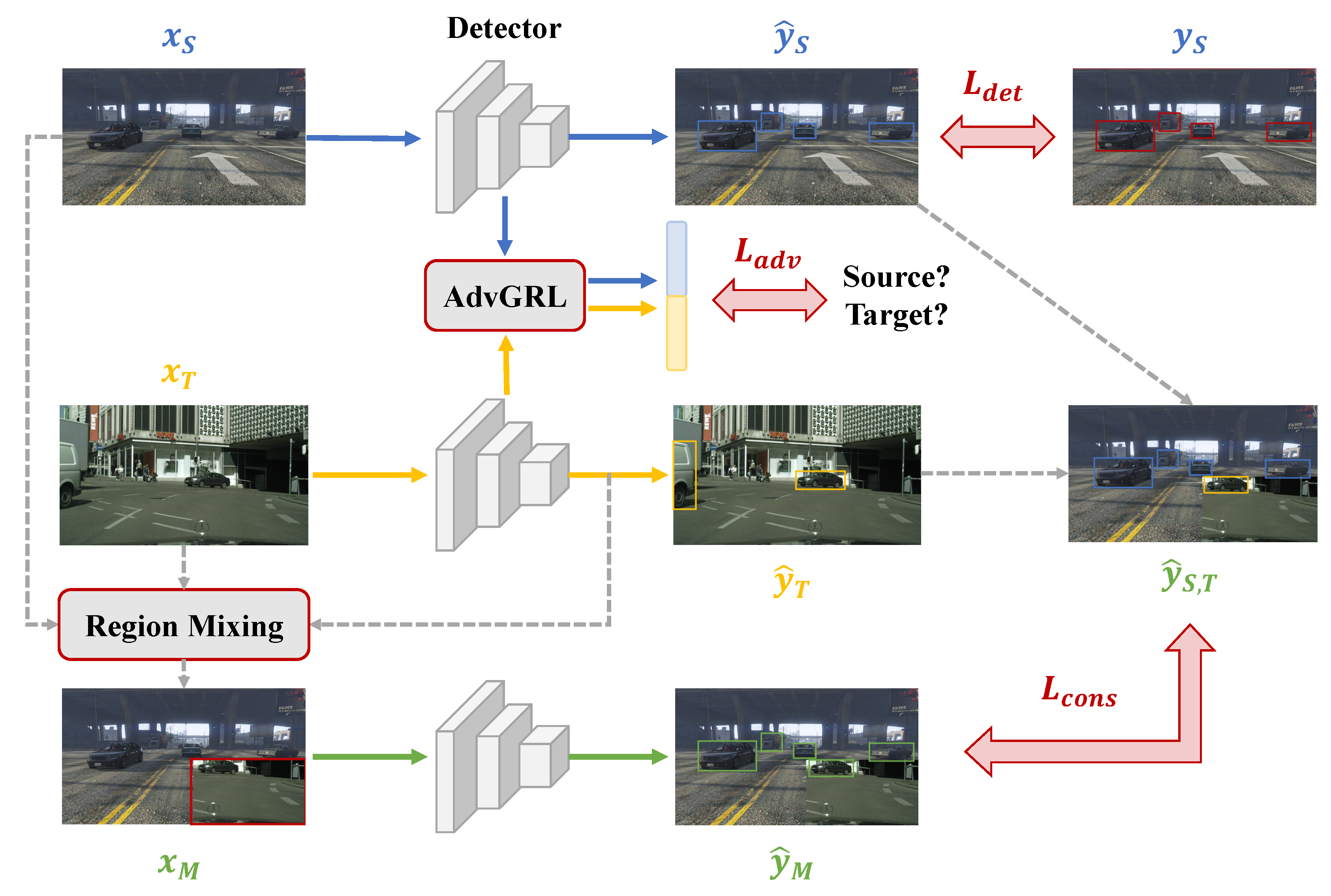

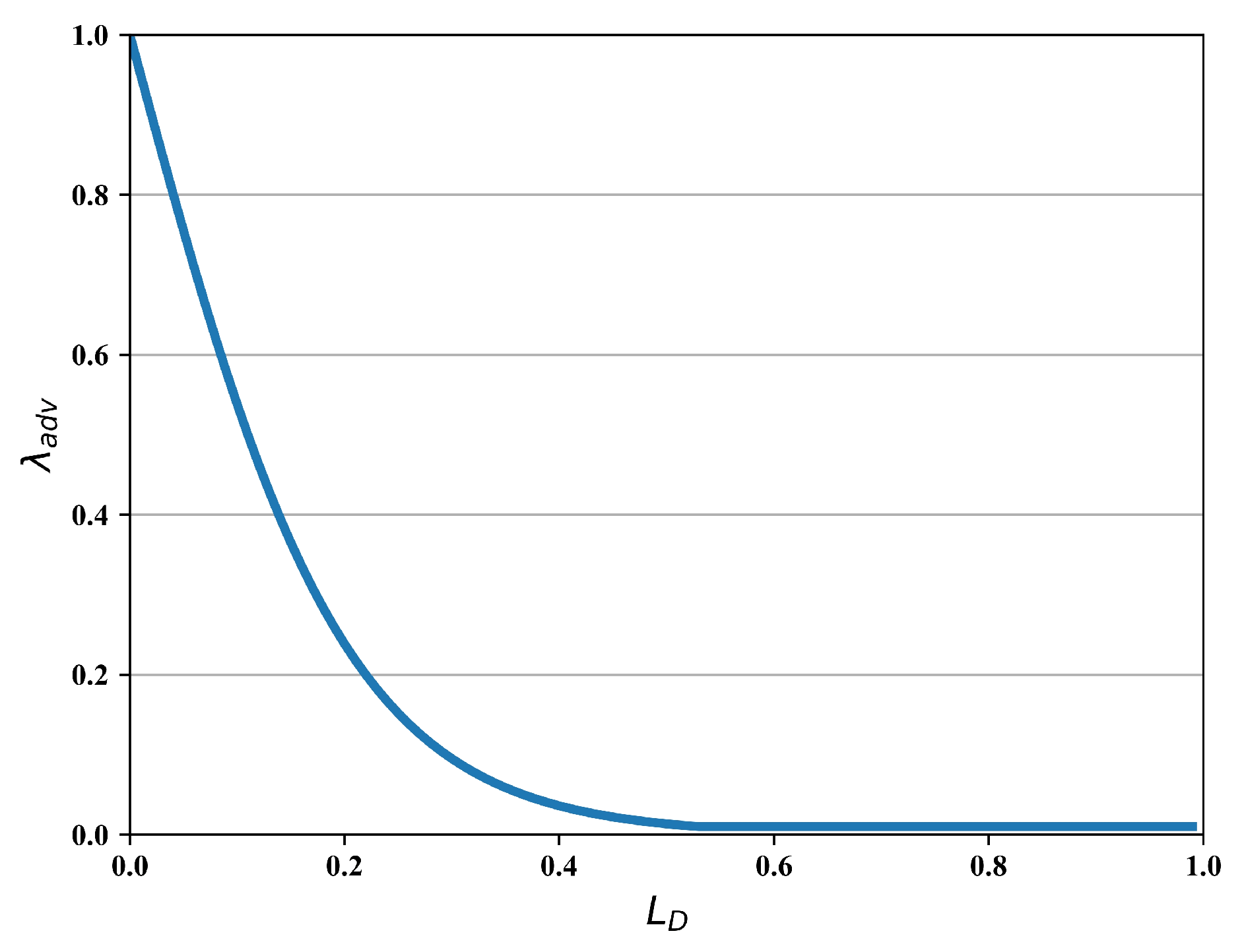
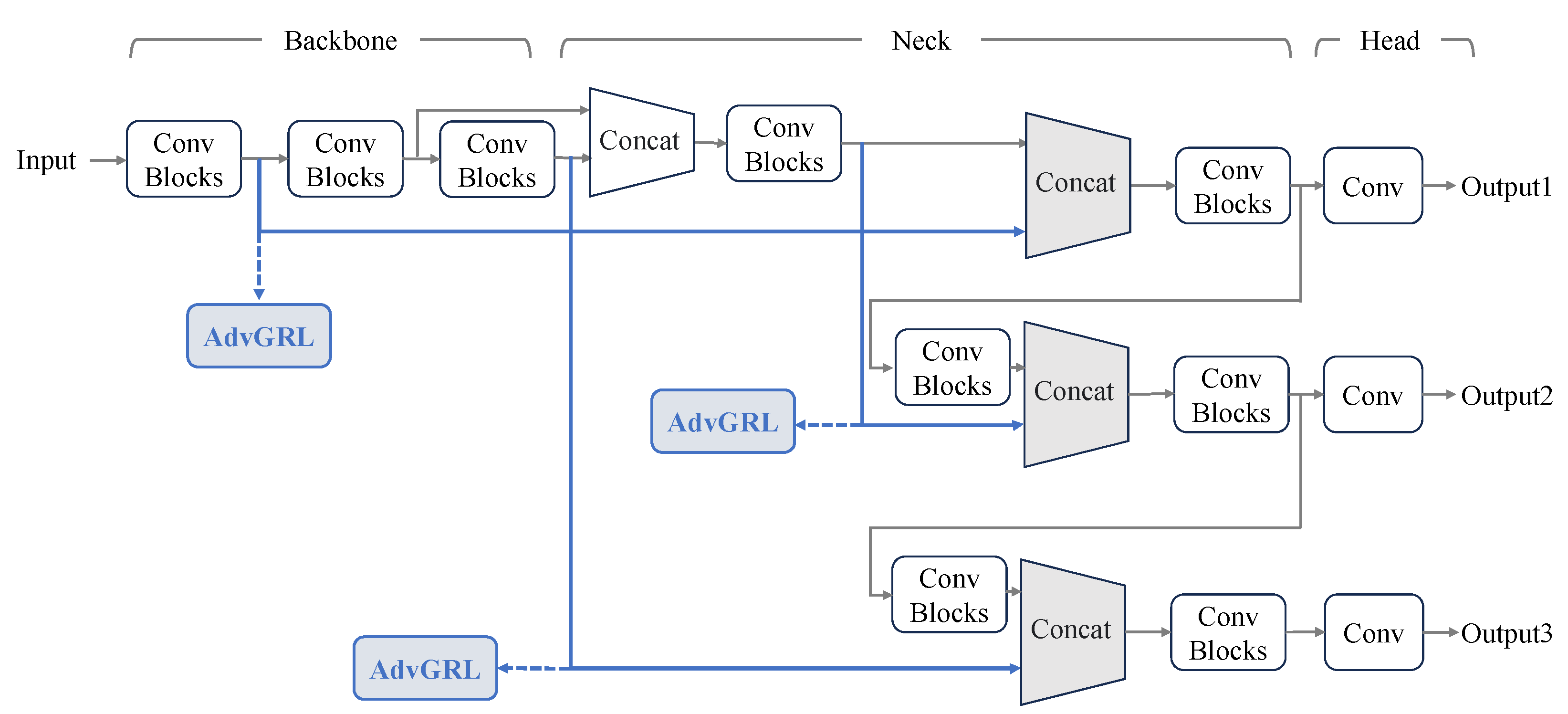
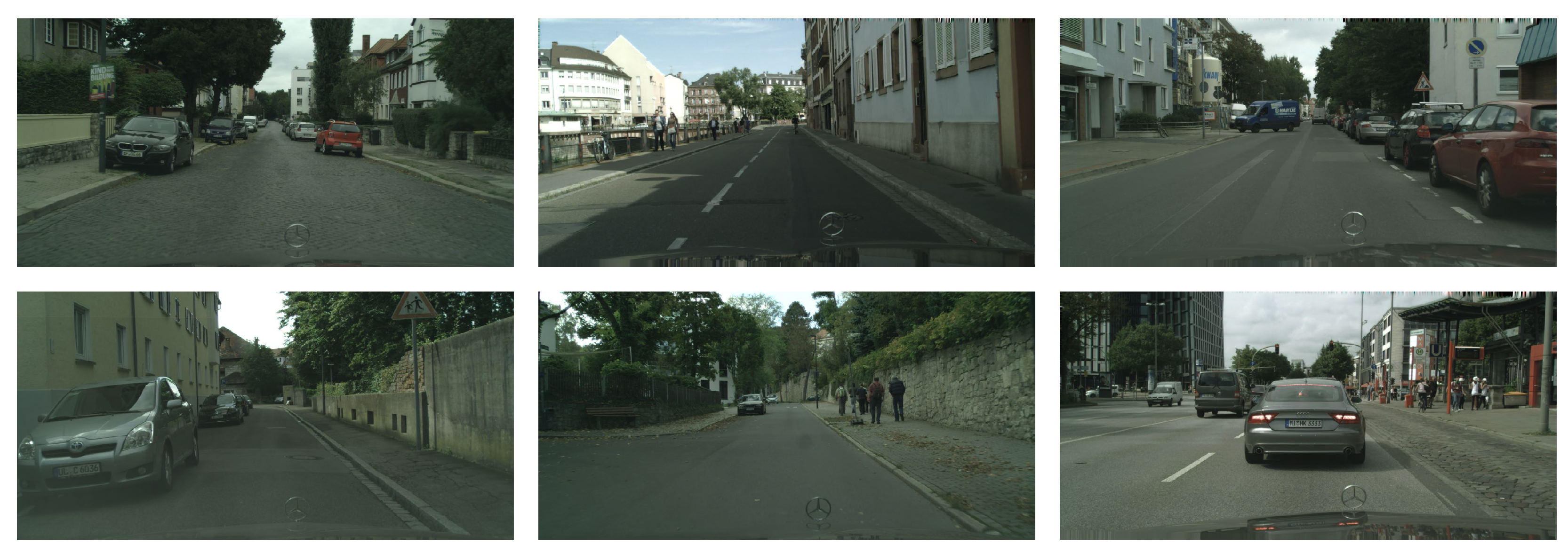


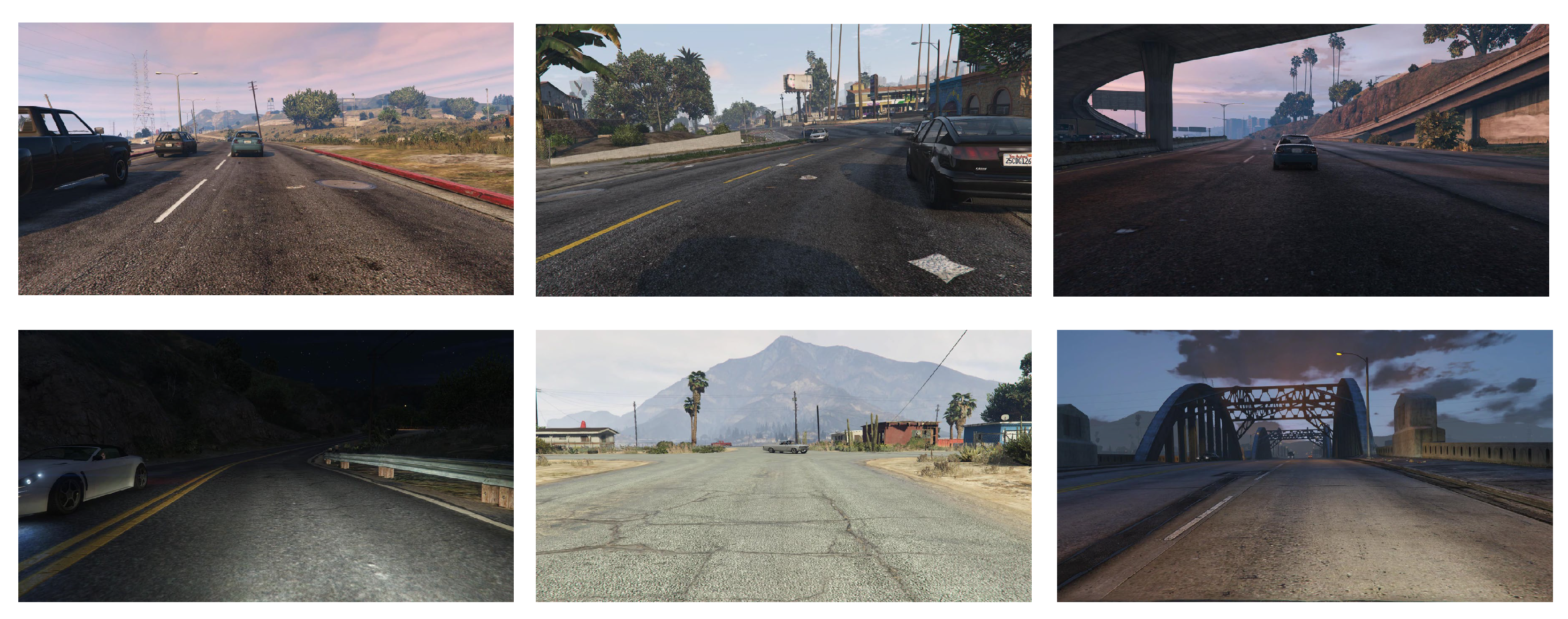
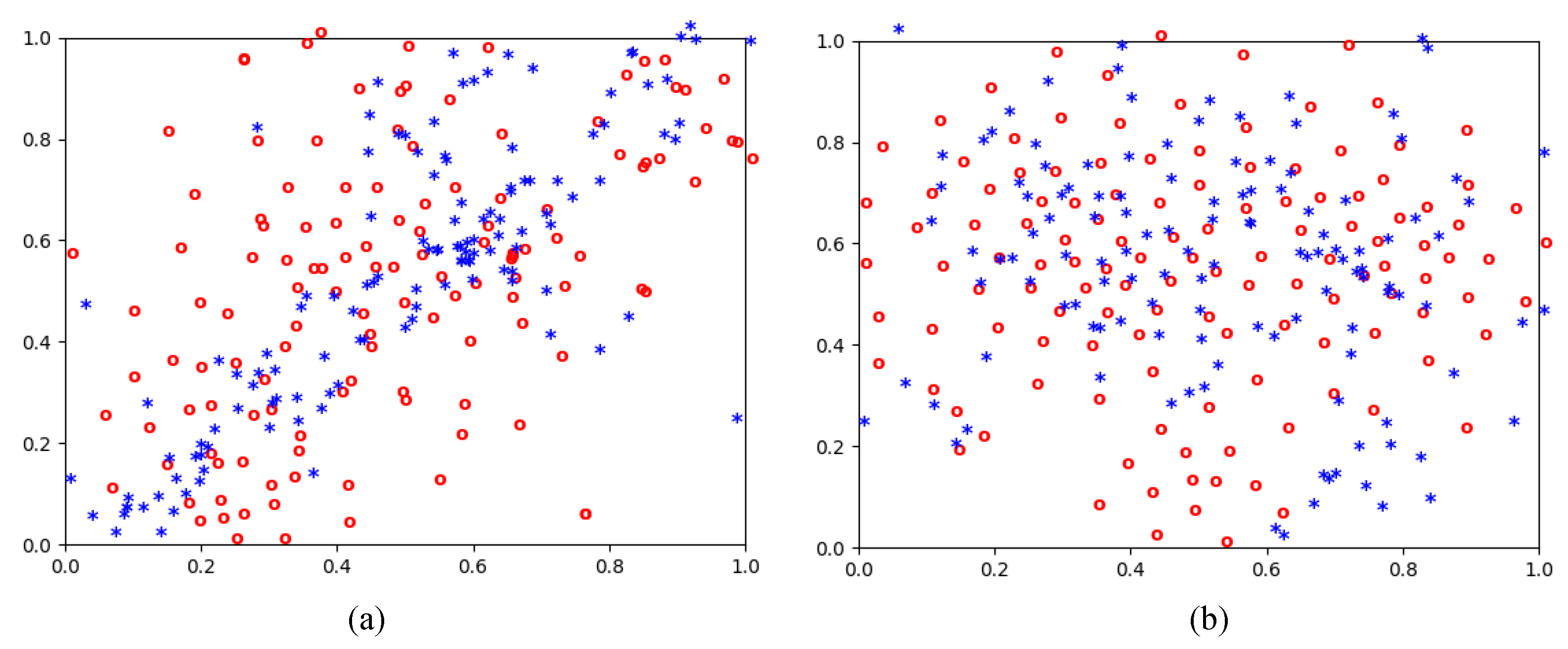

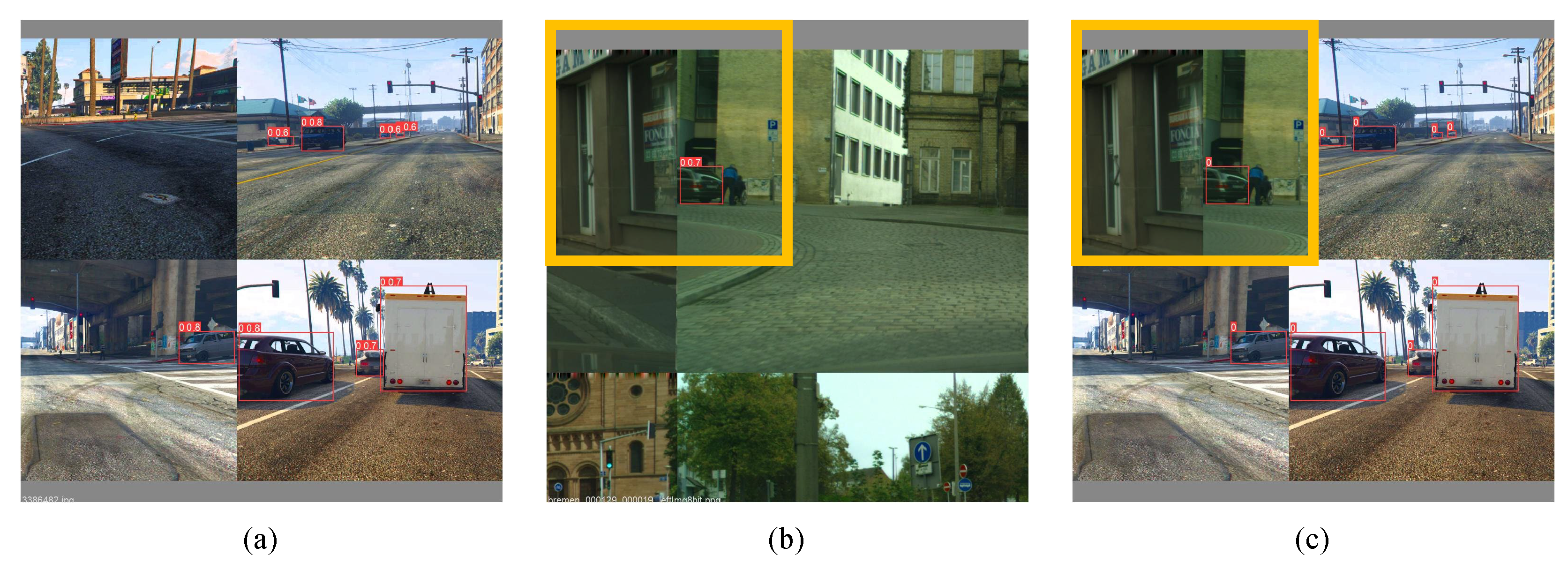


| Domain Adaption | Method | mAP (%) |
|---|---|---|
| Cross-weather | Baseline | 34.7 |
| AdvMix | 50.1 | |
| Oracle | 51.8 | |
| Cross-camera | Baseline | 46.6 |
| AdvMix | 57.1 | |
| Oracle | 78.2 | |
| Synthetic-to-real | Baseline | 59.4 |
| AdvMix | 65.3 | |
| Oracle | 78.2 |
| Category | Method | AP (%) | mAP (%) | |||||||
|---|---|---|---|---|---|---|---|---|---|---|
| Person | Car | Train | Rider | Truck | Bicycle | Bus | Motorcycle | |||
| Adversarial Method | CDN [50] | 35.8 | 50.9 | 29.8 | 45.7 | 30.1 | 36.5 | 42.5 | 30.8 | 36.3 |
| EPM [26] | 44.0 | 57.1 | 39.7 | 43.6 | 29.4 | 36.1 | 44.9 | 29.0 | 40.2 | |
| RPN-PR [18] | 33.6 | 49.6 | 46.0 | 43.8 | 32.9 | 36.8 | 45.5 | 35.7 | 40.5 | |
| SAPN [51] | 40.8 | 59.8 | 37.5 | 46.7 | 24.3 | 40.7 | 46.8 | 30.4 | 40.9 | |
| UADAN [16] | 36.5 | 53.6 | 42.7 | 46.1 | 28.9 | 38.9 | 49.4 | 32.3 | 41.1 | |
| MeGA [17] | 37.7 | 52.4 | 46.9 | 49.0 | 25.4 | 39.0 | 49.2 | 34.5 | 41.8 | |
| SCAN [12] | 41.7 | 57.3 | 48.7 | 43.9 | 28.7 | 37.3 | 48.6 | 31.0 | 42.1 | |
| DA-AD [14] | 36.5 | 54.3 | 48.7 | 46.7 | 30.3 | 39.1 | 51.2 | 31.6 | 42.3 | |
| SSOD [11] | 38.8 | 57.2 | 51.9 | 45.9 | 29.9 | 40.9 | 50.2 | 31.9 | 43.3 | |
| MGA [27] | 43.9 | 60.6 | 39.0 | 49.6 | 29.6 | 42.8 | 50.7 | 38.3 | 44.3 | |
| Self-training Method | CTRP [21] | 32.7 | 50.1 | 25.4 | 44.4 | 21.7 | 36.8 | 45.6 | 30.1 | 35.9 |
| SC-UDA [20] | 38.5 | 56.0 | 29.7 | 43.7 | 27.1 | 39.5 | 43.8 | 31.2 | 38.7 | |
| FL-UDA [30] | 34.1 | 51.9 | 25.7 | 44.4 | 30.4 | 37.2 | 41.8 | 30.3 | 37.0 | |
| IRG [19] | 37.4 | 51.9 | 25.2 | 45.2 | 24.4 | 41.6 | 39.6 | 31.5 | 37.1 | |
| GIPA [32] | 32.9 | 54.1 | 41.1 | 46.7 | 24.7 | 38.7 | 45.7 | 32.4 | 39.5 | |
| ConfMix [13] | 45.0 | 62.6 | 40.0 | 43.4 | 27.3 | 33.5 | 45.8 | 28.6 | 40.8 | |
| SIGMA [22] | 44.0 | 60.3 | 51.5 | 43.9 | 31.6 | 40.6 | 50.4 | 31.7 | 44.2 | |
| AdvMix | 54.0 | 68.9 | 49.5 | 51.5 | 39.5 | 44.3 | 53.5 | 39.3 | 50.1 | |
| Category | Method | mAP (Car%) | |
|---|---|---|---|
| Cross-Camera | Synthetic-to-Real | ||
| Adversarial Method | MeGA [17] | 43.0 | 44.8 |
| SAPN [51] | 43.4 | 44.9 | |
| CDN [50] | 44.9 | 49.3 | |
| EPM [26] | 45.0 | 51.2 | |
| SCAN [12] | 45.5 | 52.6 | |
| SSOD [11] | 47.6 | 49.3 | |
| MGA [27] | 48.5 | 54.6 | |
| Self-training Method | CTRP [21] | 43.6 | 44.5 |
| FL-UDA [30] | 44.6 | 43.1 | |
| IRG [19] | 45.7 | 43.2 | |
| SIGMA [22] | 45.8 | 53.7 | |
| SC-UDA [20] | 46.4 | 52.4 | |
| GIPA [32] | 47.9 | 47.6 | |
| ConfMix [13] | 52.2 | 56.3 | |
| AdvMix | 57.1 | 65.3 | |
| Adversarial Structure | mAP (%) |
|---|---|
| Baseline (w/o discriminator) | 60.2 |
| Pixel-level discriminator | 60.3 |
| Global-level discriminator | 64.2 |
| Scaling Thresholds | mAP (%) |
|---|---|
| 0 (constant weight) | 64.2 |
| 8 | 64.3 |
| 10 | 65.3 |
| 12 | 64.7 |
| Mixing Strategy | mAP (%) |
|---|---|
| Baseline (w/o mix) | 59.6 |
| Vertical | 64.5 |
| Horizontal | 57.1 |
| 4-Division | 65.3 |
| 6-Division | 64.6 |
| Confidence Metric | mAP (%) |
|---|---|
| 61.4 | |
| 65.3 |
| Image Resolution | Domain Adaptive Method | mAP (%) | ||
|---|---|---|---|---|
| Name | Adversarial Structure | Mixing Strategy | ||
| Baseline | 49.3 | |||
| Adv-only | ✔ | 51.3 | ||
| Mixing-only | ✔ | 54.6 | ||
| AdvMix | ✔ | ✔ | 56.7 | |
| Baseline | 59.4 | |||
| Adv-only | ✔ | 59.6 | ||
| Mixing-only | ✔ | 60.2 | ||
| AdvMix | ✔ | ✔ | 65.3 | |
| Class | Instance Number | Baseline AP (%) | AdvMix AP (%) | Oracle AP (%) |
|---|---|---|---|---|
| Person | 3171 | 45.3 | 54.0 | 57.5 |
| Car | 4224 | 55.5 | 68.9 | 72.6 |
| Train | 22 | 4.6 | 49.5 | 48.4 |
| Rider | 481 | 43.6 | 51.5 | 53.3 |
| Truck | 88 | 24.3 | 39.5 | 41.2 |
| Bicycle | 996 | 38.1 | 44.3 | 45.7 |
| Bus | 86 | 39.0 | 53.5 | 53.7 |
| Motorcycle | 135 | 27.5 | 39.3 | 41.5 |
Disclaimer/Publisher’s Note: The statements, opinions and data contained in all publications are solely those of the individual author(s) and contributor(s) and not of MDPI and/or the editor(s). MDPI and/or the editor(s) disclaim responsibility for any injury to people or property resulting from any ideas, methods, instructions or products referred to in the content. |
© 2024 by the authors. Licensee MDPI, Basel, Switzerland. This article is an open access article distributed under the terms and conditions of the Creative Commons Attribution (CC BY) license (https://creativecommons.org/licenses/by/4.0/).
Share and Cite
Chen, R.; Lv, D.; Dai, L.; Jin, L.; Xiang, Z. AdvMix: Adversarial Mixing Strategy for Unsupervised Domain Adaptive Object Detection. Electronics 2024, 13, 685. https://doi.org/10.3390/electronics13040685
Chen R, Lv D, Dai L, Jin L, Xiang Z. AdvMix: Adversarial Mixing Strategy for Unsupervised Domain Adaptive Object Detection. Electronics. 2024; 13(4):685. https://doi.org/10.3390/electronics13040685
Chicago/Turabian StyleChen, Ruimin, Dailin Lv, Li Dai, Liming Jin, and Zhiyu Xiang. 2024. "AdvMix: Adversarial Mixing Strategy for Unsupervised Domain Adaptive Object Detection" Electronics 13, no. 4: 685. https://doi.org/10.3390/electronics13040685
APA StyleChen, R., Lv, D., Dai, L., Jin, L., & Xiang, Z. (2024). AdvMix: Adversarial Mixing Strategy for Unsupervised Domain Adaptive Object Detection. Electronics, 13(4), 685. https://doi.org/10.3390/electronics13040685







